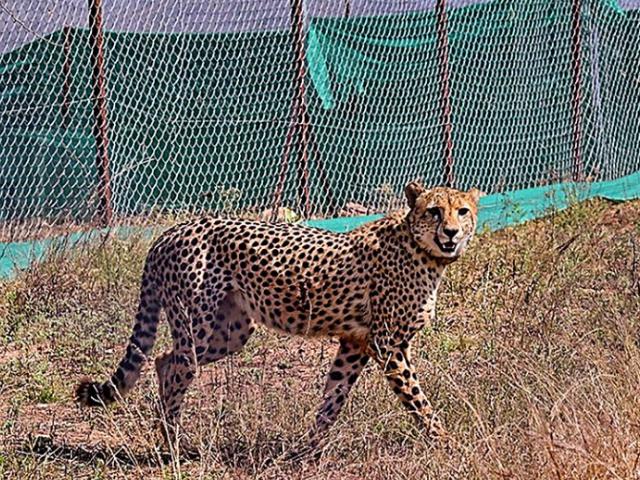While reporting for television and the print media during a long period of over three decades , I noticed a tendency of Indian bureaucracy - most of the bureaucrats in India seem to have trained themselves for hiding information. There is also lack of transparency especially while dealing with the community outside their sphere. International experts in cheetah translocation project in Kuno national park are also experiencing the same issue. During the recent cheetah deaths, especially after July 11 when a male cat died, the first from alleged satellite tracking -collar abrasion, it was revealed that the African experts were begging for information from India officials .There was a delay of more than 24 precious hours when some details, not all, reached the African experts as Indian authorities made "assumptions" over the injury caused to Tejas, the male cheetah by a female. He later died. He was followed by Suraj but the reason was the same, deterioration of the radio collar abrasion leading to maggots and death due to septicaemia shock. Meanwhile, on August 2, another cheetah, Tiblisi or Dhatri, died in Kuno national park , ninth cheetah death including the three cubs.
"Had to Beg For Info" on Cheetah Death
After the death of Tiblisi, the 3.5 year old female from Namibia, 14 cheetahs remained inside the boma. After the revelation of collar abrasion when the authorities started recapturing all the cheetahs to bring them back in enclosures and started their health checkup , a female cheetah Dhatri could not be tracked . She was found dead on August 2. “Her cause of death is unknown and could be ascertained only after post mortem”, an official press release later said. Now there is only one female cheetah remaining in the wild and officials are extremely concerned over her health too. “Her collar had developed some technical issue and she could not be located for long in the drenched forest”, sources said. Now back to the transparency issue. In the Supreme Court case, the affidavit filed by the MoEFC&C and NTCA also attached a document ( a letter ) from a South African expert. Addressed to the apex court after the death of Tejas and Suraj in mid July, the letter was signed by Dr Adrian Tordiffe , renowned wildlife veterinarian from South Africa. Though it also carried the names of other African experts ,only Dr Tordiffe signed it. According to Indian Express , one letter was also written by Dr Laurie Marker, executive director of Namibia’s Cheetah Conservation Fund raising almost similar issues.
Also read: Bringing African Cheetahs to India a Wrong Decision ?
Referring to the death of Tejas, Adrian writes, " he died around 1400 hrs without receiving any treatment. .We were not informed of any of the day's events at Kuno- at no time had we received any information about what had transpired .Instead were dismayed to learn what had happened via the media".The SA experts’ letter highlighted how the project’s current management has “little or no scientific training” and how the foreign experts’ “opinions” are being “ignored”. One of the letters also said “they had to beg for information” and how they “have become mere window dressing” for the project. The government affidavit submitted before the court said , “The issues raised by these documents ( letters) will be put before the steering committee for detailed deliberations”.
Lack of Transparency Leads to Cheetah Death ?
“Although we are listed on the Cheetah project Steering Committee as international experts, we have never been consulted by them or invited to any of their meetings,” Tordiffe’s letter said . It said that the field team wrongly assumed that the male cheetah, spotted at around 11 am on July 11 with wounds on the back of his neck, was injured by a female cheetah which was an “extremely unlikely” scenario. “The staff at Kuno left the injured male, deciding rather to locate the female to check if she was also injured. During that time the condition of the male deteriorated, and he died at around 2 pm without having received any treatment,” the letter said. The experts claimed they heard from Kuno only the next morning when a summary and some photos of the post mortem were shared.“No comment was made about the inflammation of the skin over the neck or the very large number of maggots that were clearly visible in the photo,” the letter said. . It said that they ( veterinarians) could diagnose the radio collar issue only when they received a video clip after the death of yet another cheetah on July 14. “ Had they been shown pictures or had a description of the “wounds,” they would have alerted authorities to act to minimise the risk to the other animals. “Instead, we were largely excluded from the process",” the letter said.
Also read:Not Leopards, A Different 'Predator' is Killing Kuno Cheetahs
Those reporting the issue in the media -India and abroad- found it extremely difficult to get information over the project. After the satellite collar led -injuries and cheetah deaths , the Union ministry of environment forest and climate change (MoEFC&C) issued a denial and said that the deaths were caused by “ natural causes”. There are reports in the media attributing these Cheetah deaths to other reasons including their radio collars etc. Such reports are not based on any scientific evidence but are speculation and hearsay, a Press Information Bureau (PIB) release said on July 16. There is also a ban on medical interaction over cheetah project. Of the 20 cheetahs brought to India, the first set of eight cats from Namibia were released into the Kuno National Park in Madhya Pradesh by Prime Minister Narendra Modi on September 17 last year and another 12 cheetahs landed from South Africa this February. Since the first two cheetahs were released in the wild on March 11, six adults and three cubs have died in Kuno.




Comments
Post a Comment